7 Parts of a Shovel: Shovel Anatomy Diagrammed
Author: Chris Miller | Editor: Omar Alonso
Review & Research: Jen Worst & Chris Miller
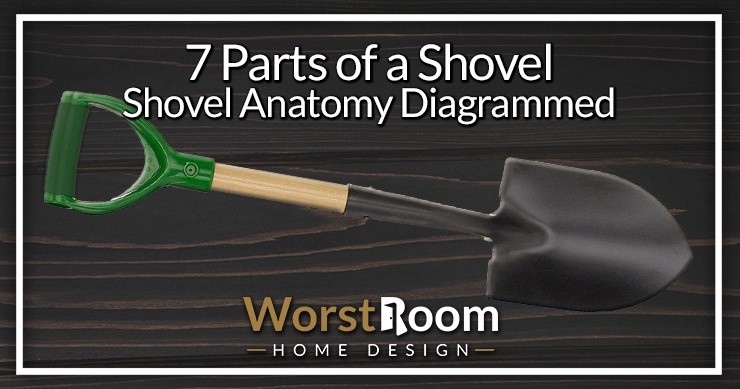
One of the most common tools that people use around the globe is a shovel. It comes in many different sizes and shapes, comprised of specific parts of a shovel, each of which that serve distinct purposes.
Depending on the task, the shape of the shovel can change. However, the shape and size might be different, but the parts that come together to form a shovel in its general form remain the same.
Here, we are going to describe the parts of a shovel so that you don't get confused while buying them. So, if you want to know more about how these tools are built, keep reading below.
Shovel Diagram
It's important to understand the anatomy of a shovel (or any tool you're using) so when it comes time to talk about it with others, you'll know the shovel parts by name and can communicate effectively.
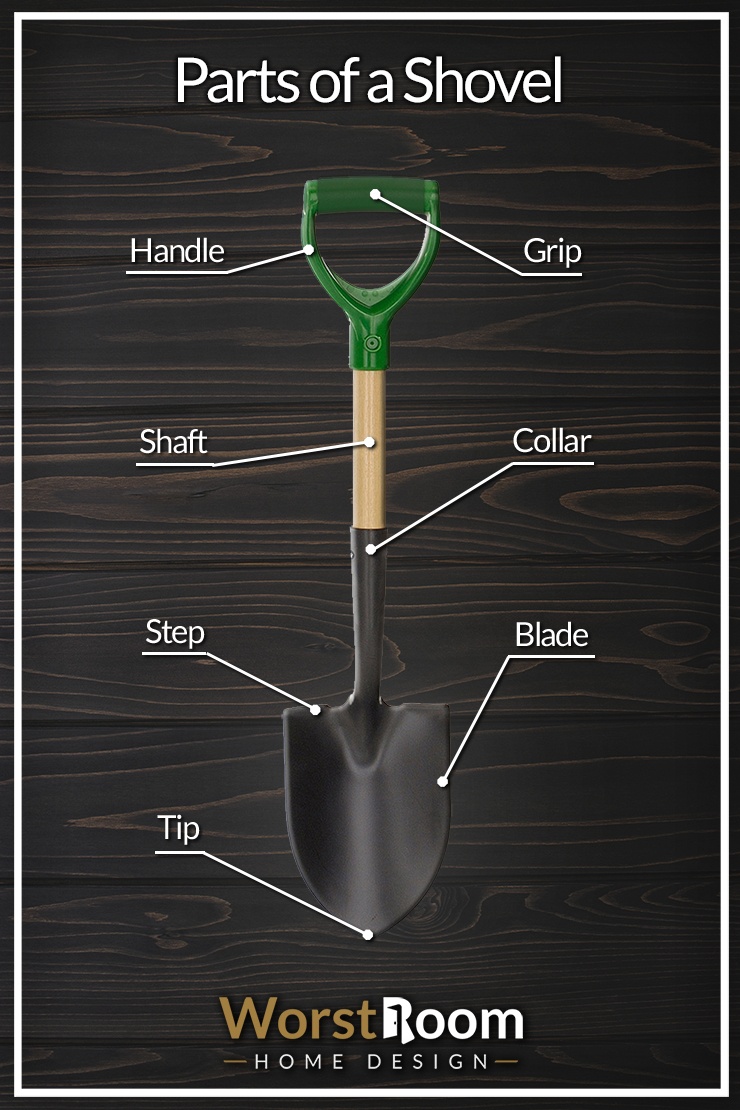
Hopefully, with a few short studies of the shovel diagram above, you can quickly identify all of the components of a shovel at home, on the job site, or in the store. We'll explain what each piece does below.
Parts of A Shovel Explained
All types of shovels only need six separate components to take on its form. And they are the blade, tip, step/kick plate, handle, collar, grip, and handle.
Although the shape and structure of these parts may vary depending on the type of the shovel, you will surely see these parts in every kind of shovel. Let's have a look at the different parts of the shovel.
Grip
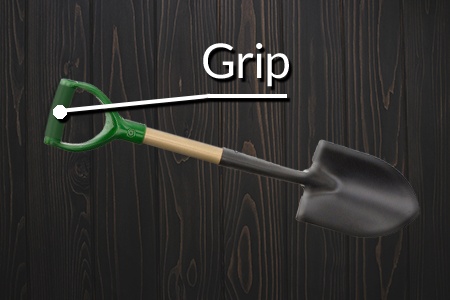
The grip is the topmost part of a shovel. We wrap our fingers around the grip to hold the shovel. There are three types of grips that you will see on a shovel. Check them out.
No Grip
Although it sounds strange, some shovels come with no grip. Instead of holding the grip, you need to hold the handle directly. It might seem a bit off, but the material that manufacturers use in such types makes it easier to grasp the shovel comfortably and do the jobs with precision at the same time.
However, this style of grip is inappropriate for heavy-duty jobs. This category's most commonly used materials are fiberglass, wood, metal, etc. Occasionally one of these materials will feature bumps, divots, and pits to help increase friction during gripping.
Non-Slip Grip
Non-slip grips are the most popular among users. The material of the grip is an important part of making it non-slip. We usually see silicone or rubber as a material of a non-slip grip. These materials help to hold the grip even though it is raining or your hand is sweating.
This grip remains dry in wet conditions. Besides, this type of grip is among the most comfortable ones when you have to work at a stretch for a long period.
Foam Grip
Another grip type that you can see on a shovel is the foam grip. The foam grip is comfortable to grasp and feels great when you use the shovel. Although, this grip isn't very strong, and it tends to wear out with time.
Handle
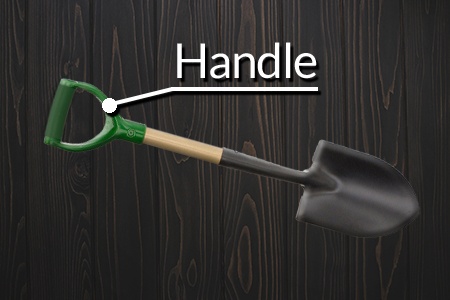
The handle (sometimes simply the shaft without any extra parts) is a pole-like structure that comes after the grip. This part of the shovel can be formed in different shapes to perform different sorts of tasks. Let's check the three types of handles that we see more often in a shovel.
Straight Handle
The straight handle are the most popular ones. You may have better control with this type and deliver the best output through it. However, this handle is more appropriate for tall people because it has a long shaft.
D-Grip Handle
Another common handle that you may have observed is the D-grip handle. The main part of the grip usually remains detached from the body, and you might need to attach it externally to utilize the handle. This type of handle can carry a great deal of weight when the shaft and the D-grip come in one piece.
Crutch Handle
Another name for the crutch handle is T-grip. These parts of a shovel are more prolonged horizontally than the D-grip handles and are perfect for wide-handed users. They're also quite useful in you're digging in a kind of material that benefits from rocking the shovel back and forth.
Shaft
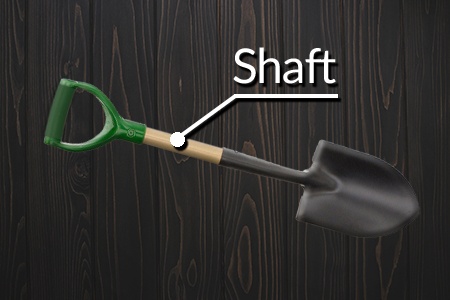
The shaft is the long stretch of material that provides length to the tool. This long length makes the tool comfortable to use while standing upright and helps provide leverage during the lifting and moving of soil, rocks, etc.
The shaft is the part that is most likely to break over time, because it bears most of the weight and impact of the work being done. Many shafts are created from wood, though newer shovels feature a much improved fiberglass material which is not only stronger but also shock absorbent. Fiberglass doesn't concern itself with humidity problems like shrinking, expanding, mold, and rot. But if they do break they're much harder to replace than a quick swap of a wood handle..
Collar
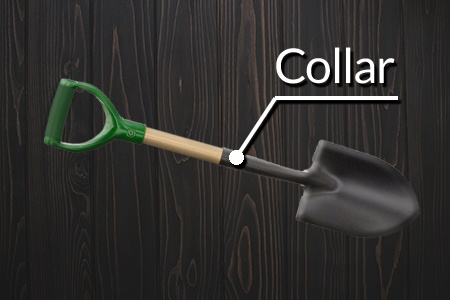
Moving downwards, here comes the collar, sometimes called the socket. In this part, the shaft and the blade meet with each other, and with the help of one or two screws or rivets, they remain attached and stable, able to withstand the non-vertical force applied when digging and lifting.
Even glue may be used to join these two components of certain inexpensive shovels. However, this technique results in a highly fragile and easily broken shovel. If you need to change the blade or shaft, you can remove the screw or the rivet and replace whichever part you need to change.
Step / Kick Plate
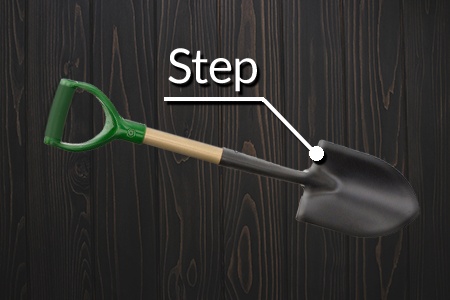
A kickplate is also known as a step. And it is located in the upper part of the blade. A digging shovel has the most prominent and strongest step because of its functionality.
As implied by the name, we put pressure on the step with our feet to dig into the ground. It makes the digging easier, and you can achieve a better result without wasting much of your energy. Due to these kick plates, shovels are the most prominent types of tools for digging available, though there are others, too.
Blade
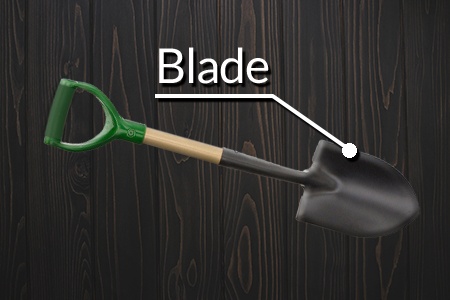
The blade is the lowest part of a shovel, which we use to dig in or scrape something away from the ground. You can think of it as the sharp side of the scooping surface. There is a wide range of blade types that we can incorporate with a shovel. Depending on the job, the shape and size of the blade change.
Tip
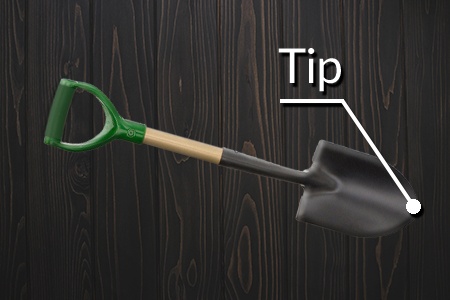
The tip is the edge of the blade. It is the last part of a shovel and is located the farthest from the grip. This part of a shovel can be pointed, square, round, or any other shape that might be required for the intended use.
What You Should Consider When Buying a Shovel
If you choose the correct shovel, it may be a terrific tool for getting the work done. So, when you are thinking about buying a shovel, you should keep some facts in mind to make your purchase fruitful. We have some important facts that you should consider before making the purchase. Let's have a look.
The Anatomy of a Shovel
The entire purpose of this article is to help you associate visually the actual shovel parts with the shovel part names. Referencing the shovel diagram above will help you achieve this goal, and since it's not an overly complex tool, you'll get it in no time.
Purpose of Use
It is no wonder that all the parts of a shovel come together to be a great gardening tool. But you can use these types of tools for other purposes as well. Besides, different shovels serve different purposes.
For example, some shovels are made for digging, some are made for scraping, and some can just create post holes. So, know your specific need and then buy a shovel that is made for that purpose.
Shape of the Blade
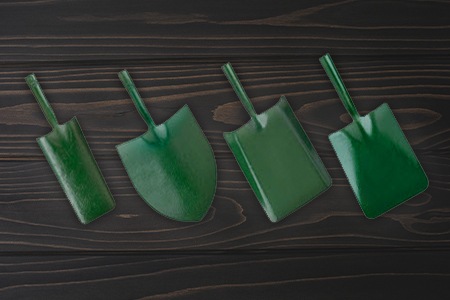
Shovels usually have a bowl shape on their blade and can move quantities of soil, dirt, sand, and even concrete mix. Because of their structure, they are able to hold a greater volume and can complete the task in less time.
Shovels usually have a pointed tip, which is great for digging soil from a garden bed. Some shovels have a straight end, which is useful when scooping up something from a flat surface. Some of the various shovel blade shapes you'll encounter are (with the first three being most common):
- Round mouth
- Square mouth
- Taper mouth
- Square trench
- Cable layer
- Newcastle drainer
So, firstly, know your requirements and then look for a specific type of shovel. If you can buy the right one as you intend and maintain the product in the correct manner, then that one shovel can serve you for the rest of your life.
Size
Size matters if you want to increase efficiency while working with a shovel. But how do you determine the right size shovel for a particular person? The perfect height should be 4 inches less than the shoulder of a person. So, before making the purchase, look for the shovel that fulfills this requirement.
That's not to say there aren't smaller shovels, such as a gardening trowel, and the kind that come in sets of fire pit tools. These all have their use, and I want to make sure you aren't discounting them.
Weight
Most people ignore checking the weight of a shovel when it is one of the most important factors that you should keep in mind. If you work with a heavy shovel, it will tire you out easily. It helps to have as many shovel parts made of fiberglass (like the handle) rather than dense wood or metal.
On the other hand, a lightweight shovel cannot pull off any heavy-duty job. So, choosing the right weight is crucial to increase efficiency.
Material
There are several choices for you when choosing the material for your shovel. The classic wooden shovel is the most common, but when it comes down to the most durable one, it is certainly not. The fiberglass has replaced the wooden handle to give more strength and durability to the product.
Now, if we talk about the material of the blade, solid steel is the most popular choice for that. Some shovels have titanium blades, which makes them lightweight and sturdy. Furthermore, you should inspect the collar's material, as it is what holds the blade and handle together with screws.
The Parts of a Shovel to Understand
Choosing the right shovel isn't as simple as it looks. Besides, this product requires some maintenance if you want it to last, which is why it helps to understand the anatomy of a shovel. Depending on its use and care, a shovel can last for years and may even decay within a short time as well.
Hopefully, our article will help you understand the importance of knowing the parts of a shovel, and the tips will help you buy the best one for your needs.



